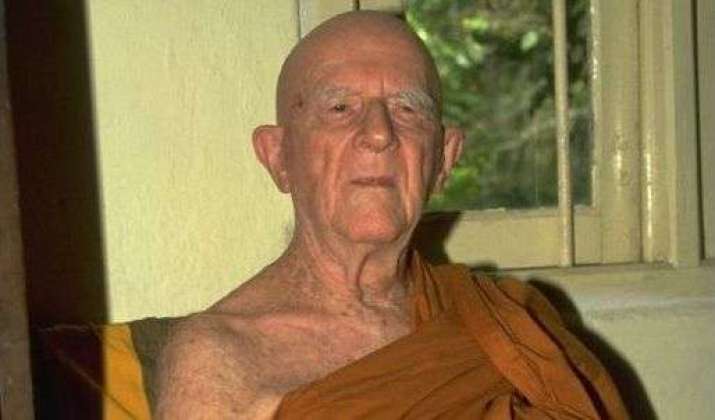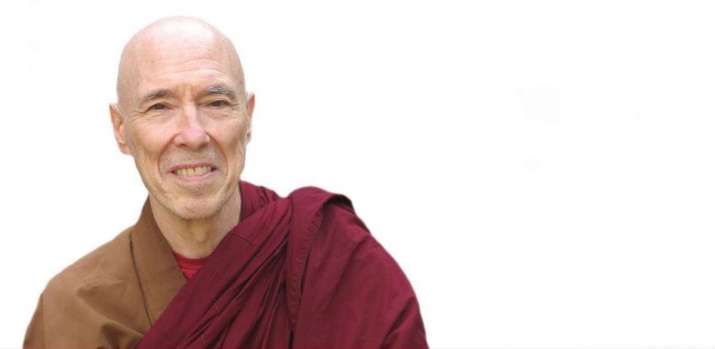FEATURES|COLUMNS|Theravada Teachings
A Reminiscence About My Theravada Teachers
 Venerable Nyanaponika. From wikipedia.org
Venerable Nyanaponika. From wikipedia.orgHaving harbored a predilection toward Buddhism from the time I was a teenager in the late 1950s, throughout my university studies, and later as a lecturer at the University of Maryland, Munich Campus, I one day ended up in the Ancient Royal Forest, in Kandy, Sri Lanka, in the mid 1980s, where the Buddhist Publication Society had kindly arranged for me to visit the Forest Hermitage during prescribed visiting hours between four and five o’clock in the afternoon.
From the moment I entered the door I was met with loving-kindness, both from Venerable Nyanaponika, who was then in his eighties, and Bhikkhu Bodhi, who was assisting him at the Forest Hermitage.
In due course, I was allowed to be seated on a low wicker chair near the window, just inside the front door, facing Ven. Nyanaponika, who was sitting in an armchair, while Bhikkhu Bodhi was seated at a table to his left, facing toward me. I can still see it as though it were yesterday.
After some preliminary exchanges, I posed the question I had come to ask: “What is the heart of Theravada Buddhism?” Ven. Nyanaponika smiled and replied, “Why look anywhere but in the words of the master?” And he told me to read The Word of the Buddha and The Path to Deliverance by his own teacher, Ven. Nyanatiloka.
Bhikkhu Bodhi, who could see that I might have trouble remembering the titles, wrote them down for me and explained that I would find the two volumes in the Buddhist Publication Society bookshop in Kandy, down near the lake.
Through this introduction, they set me on the Noble Eightfold Path.
In many subsequent visits over the next five years it was always the same: the seating arrangement remained unchanged, I would ask a question and Ven. Nyanaponika would answer in a few words, usually quoting the Buddha directly from the texts, while Bhikkhu Bodhi would then help by telling me where I could find the appropriate references and resources.
In those days, Ven. Nyanaponika was still walking and not showing visible signs of his deteriorating health. He was a benevolent monk full of loving-kindness, who had become a role model for many others who followed in his footsteps. Bhikkhu Bodhi, at that time, seemed to me to be a bright, young (relative to me at least) PhD in philosophy who happened to be in the right place at the right time, with the right skills and aptitudes to carry on the tradition of the venerables Nyanaponika, Nyanatiloka, and Nanamoli.
In those days, there was still a formidable amount of work to be done in translating and explicating the Pali texts in accordance with the Theravada tradition, as a guide to the practice of monks and for lay practitioners.
Back then, those who were in a position to benefit may not have been so many, but later, approaching the turn of the 20th century, the influence of these translated Pali texts had reached all around the world, especially as a lot of Buddhist Publication Society books and Wheels and Bodhi Leaves had been made available for free download on the BPS website.
Disseminating wider knowledge of the original Pali texts had already been Ven. Nyanatiloka’s declared mission during the first half of the 20th century, but by the time of the new millennium, it seemed to be coming to fruition in a way that only a few had earlier envisioned. This gives those who have followed in Ven. Nanaponika’s footsteps great joy and satisfaction, and equal praise is due to Bhikkhu Bodhi, who was eventually able to finish the long-term task envisioned by Ven. Nyanatiloka and later perpetuated by Ven. Nyanaponika.
Bhikkhu Bodhi has always been very kind to me. In addition to speaking with me warmly and patiently at the Forest Hermitage, I also corresponded with him during the 1980s and he took the time to help me edit the text of a lecture I had been asked to give by the University of Maryland on The Heart of Theravada Buddhism, the Noble Eightfold Path, which followed the line of Bhikkhu Bodhi’s own book on the same topic, combined with some observations taken from Ledi Sayadaw, Ven. Nyanatiloka, and Ven. Nyanaponika. I shall ever be grateful to him for having taken the time to help me when he, himself, was fully engaged in writing his own now famous translations.
One cannot but be amazed at the quantity and quality of scholarly output produced by Bhikkhu Bodhi and those who preceded him. The huge amount of work that Bhikkhu Bodhi has done, often on the most difficult texts, will put him down in history alongside his venerable teachers. Such Theravada monks are, indeed, world treasures.
 Bhikkhu Bodhi. From youtube.com
Bhikkhu Bodhi. From youtube.comHistorically, the selfless contributions of Bhikkhu Bodhi and Venerable Nyanaponika to making the Dhamma better known in English for the benefit of others have become synonymous with the development and fulfillment of the noble and meritorious mission of the Buddhist Publication Society, a mission that continues to be successful.
Few know that much of the Buddhist Publication Society's early work was done at night, by lamplight, at the Forest Hermitage, at a time when there was still no electricity, and it was oftentimes quite cold and damp in the rainy season. It was only much later, under Bhikkhu Bodhi, that solar panels with battery storage were installed to give at least 12 volt light and limited power to run a laptop with an adapter, if one was careful to keep the batteries well topped up.
One would not think that such famous monks, so well known worldwide, often lived and worked where even water for washing and drinking was, at times, in short supply. Such matters did not, however, curb their ardent devotion. Their lives have served as brilliant examples of the noble skills of teaching and educating people about the Buddhadhamma in the Noble Lankan Tradition.
When I think back to those years approaching the end of the 20th century, I have memories of Bhikkhu Bodhi taking care of Ven. Nyanaponika as his health was frail and failing, especially in the period leading into his eventual demise in 1994. And I also think of Bhikkhu Bodhi, being then left alone up in the Forest Hermitage, suffering himself from a chronic headache condition that eventually took him back to America where he was able to receive the kind specialized care and treatment he deserved and needed.
I remember visiting the Forest Hermitage again after the turn of the century in 2005, almost a decade after Ven. Nyanaponika and Bhikkhu Bodhi had left the hermitage empty of their beloved presence—even though their books and oil lamps and furniture and beds and desks and photographs were all still there in their accustomed places.
I made that journey to pay homage to my two most beloved teachers, who by then had become hallowed figures within the Theravada tradition. While Ven. Nanaponika has passed to a better bourne, Bhikkhu Bodhi is still alive and faring well in New Jersey, not far from his native New York City, and he will hopefully smile with feelings of joy and loving-kindness if and when he reads my foregoing words of gentle praise and lasting admiration.
See more
Related features from Buddhistdoor Global
The Dhammachai Tipitaka Project: A New Critical Edition of the Pali Canon
Nine Qualities of the Buddha
For the Times They Are a-Changin’: Sakyadhita and the Radicalism We Need to Save the World
Toward a Thai Feminist Movement: Ouyporn Khuankaew
Buddhist Statuary from the Jeweled Isle














